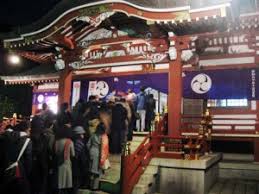New Years Day -
January 1 is New Year's Day, a national holiday and one of the biggest events on the calendar of annual festivities in Japan.


From well before dawn on New Year's Day, people flock to shrines and temples to pray for a healthy and happy year. This is called
hatsu-mode and is one of the most important rituals of the year. When we greet our acquaintances, moreover, we say "
Akemashite omedeto gozaimasu あけましておめでとうございます" (a happy new year) to convey our wishes that the year to come will be full of hope and good health.

 Nengajo
Nengajo
One thing children look forward to doing on New Year morning is reading
nengajo (New Year greeting cards) from friends and acquaintances.
Otoshidama
The biggest treat on New Years Day is receiving
otoshidama (money given as a gift at the beginning of a year) from parents, relatives, and other adults they meet during New Year.
Daruma
On January 6 and 7 each year, a temple in Takasaki, Gunma Prefecture, hosts a fair of
daruma dolls. These dolls are bright red likenesses of Bodhidharma, an Indian monk who founded Zen Buddhism in the sixth century. Legend has it that the monk sat meditating in a cave for so long (nine years!) that he lost the use of his legs.
This is why the
daruma doesn't have any limbs. It's a roly-poly doll that returns to an upright position when tipped over. It's also a good luck charm that helps people fulfill their wishes; it encourages us to keep working toward our own goals even when others are trying to knock us over.
A new doll doesn't have its eyes painted in yet; this is because the purchaser draws in one eye while making a wish, and draws in the other when the wish is fulfilled.
What will your goal for this year be???
Welcome to Year of the Snake! We're likely to see significant developments in the area of science and technology this year. Research and development are apt to flourish. This is a Water year as well, the element most closely associated with education and research, making 2013 a very special year for scientists and scholars. Snake is a great sign, a positive one, with energy that can help us face all of the challenges ahead of us.
Find out what year you were born in and see if the description sounds like you?
Write and tell me what you think below.
|
|
Tiger: 1914, 1926, 1938, 1950, 1962, 1974, 1986, 1998,
2010
Tiger people are brave, powerful, loyal, intelligent, competent, and
stubborn. Tigers make great friends. Tiger people tend not to respect their
elders and that can get them in a lot of trouble. |
|
|
Rabbit: 1915, 1927, 1939, 1951, 1963, 1975, 1987, 1999,
2011
Rabbit people are lucky, happy, independent, affectionate, bright, ambitious,
and trustworthy. Rabbit people have little interest in learning to appear smart.
They simply like to know how things work. |
|
|
Dragon: 1916, 1928, 1940, 1952, 1964, 1976, 1988, 2000,
2012
Dragon people are honest, full of energy, stubborn, loyal, strong, and
protective. Dragon people are incredibly lucky. They love flattery, and can be
attracted to bad behavior. That is their weakness. |
|
|
Snake: 1917, 1929, 1941, 1953, 1965, 1977, 1989, 2001,
2013
Snake people are wise and focused. They trust their own judgment. Snake
people cannot help but do their best because they hate to fail at anything.
Snake people believe everyone should lend a helping hand. |
|
|
Horse: 1918, 1930, 1942, 1954, 1966, 1978, 1990, 2002,
2014
Horse people are popular, cheerful, quick witted, and shy. For some reason,
horse people have a great deal of trouble believing they are loved, when in
fact, horse people are easy to like and love. |
|
|
Ram (Black or Gray Sheep): 1919, 1931, 1943, 1955,
1967, 1979, 1991, 2003, 2015
Sheep people are elegant, wise, gentle, shy, and compassionate. They can be
bossy, but that's because they're worried things will not get done correctly.
This character trait often makes money for them. |
|
|
Monkey: 1920, 1932, 1944, 1956, 1968, 1980, 1992, 2004,
2016
Monkey people are quick, funny, nosey, clever, witty, and successful. They
have wonderful memories and are well informed about everything. They tend to
chatter. This does drive friends away sometimes. |
|
|
Rooster: 1921, 1933, 1945, 1957, 1969, 1981, 1993,
2005, 2017
Rooster people are early risers, proud, alert, deep thinkers and good
speakers. They like to stay close to home. If you can break through their
natural suspicion, they make wonderful friends. |
|
|
Dog: 1922, 1934, 1946, 1958, 1970, 1982, 1994, 2006,
2018
Dog people are loyal friends, quick to learn, eager to please, and always try
to do their best. They prefer to be with people they know and like. Dog people
cannot stand injustice. |
|
|
Pig: 1923, 1935, 1947, 1959, 1971, 1983, 1995, 2007,
2019
People who are born in the Year of the Pig are intelligent, sincere, brave,
popular, and treat all people with great kindness. Pig people are often late and
often forgetful. |
|
|
Rat: 1924, 1936, 1948, 1960, 1972, 1984, 1996, 2008,
2020
People born in the Year of the Rat are famous for cheerfulness and kindness.
They are generous with those they love. Rat people love to gossip. That can cost
them many friendships if they are not careful. |
|
|
Ox: 1913, 1925, 1937, 1949, 1961, 1973, 1985, 1997,
2009, 2021
Ox people are easy going and have a great deal of self-assurance that helps
help them to be successful. Ox people have thoughtful responses. Ox people love
deeply and share their strength with those they love.
|

































































